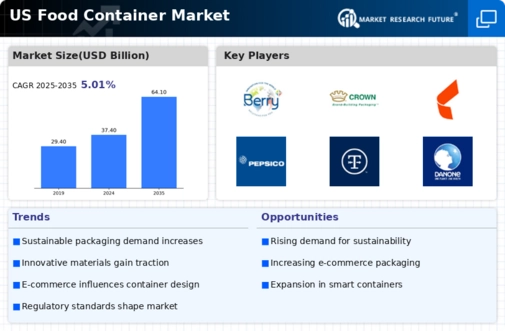The food storage container market exhibits a dynamic competitive landscape, characterized by a blend of innovation and strategic positioning among key players. Companies such as Rubbermaid (US), Tupperware (US), and Pyrex (US) are at the forefront, each leveraging unique strategies to enhance their market presence. Rubbermaid (US) focuses on sustainability, introducing eco-friendly materials in their product lines, which resonates with the growing consumer demand for environmentally responsible options. Tupperware (US), on the other hand, emphasizes direct sales and community engagement, fostering a loyal customer base through personalized service and innovative product offerings. Pyrex (US) capitalizes on its heritage of quality glassware, positioning itself as a premium brand that appeals to health-conscious consumers seeking safe and durable storage solutions. Collectively, these strategies contribute to a competitive environment that prioritizes innovation and consumer engagement.
The market structure appears moderately fragmented, with numerous players vying for market share. Key business tactics such as localizing manufacturing and optimizing supply chains are prevalent among these companies. For instance, Tupperware (US) has recently localized some of its production to reduce lead times and enhance responsiveness to market demands. This approach not only streamlines operations but also allows for greater customization of products to meet regional preferences. The collective influence of these strategies fosters a competitive atmosphere where agility and responsiveness are paramount.
In November 2025, Rubbermaid (US) announced a partnership with a leading recycling firm to develop a new line of containers made from 100% recycled materials. This strategic move underscores Rubbermaid's commitment to sustainability and positions the brand as a leader in eco-friendly solutions within the food storage segment. By aligning with a recycling expert, Rubbermaid (US) not only enhances its product offerings but also strengthens its brand image among environmentally conscious consumers.
In October 2025, Tupperware (US) launched a digital platform aimed at enhancing customer engagement through virtual cooking classes and product demonstrations. This initiative reflects Tupperware's strategic pivot towards digital transformation, allowing the company to connect with consumers in innovative ways. By leveraging technology, Tupperware (US) is likely to enhance brand loyalty and drive sales through interactive experiences that resonate with modern consumers.
In September 2025, Pyrex (US) expanded its product line to include a new range of microwave-safe containers designed for convenience and versatility. This expansion not only caters to the increasing demand for multifunctional kitchenware but also reinforces Pyrex's reputation for quality and safety. By continuously innovating its product offerings, Pyrex (US) positions itself to capture a larger share of the market, appealing to consumers who prioritize both functionality and health.
As of December 2025, the competitive trends in the food storage container market are increasingly defined by digitalization, sustainability, and the integration of advanced technologies. Strategic alliances, such as those seen with Rubbermaid (US) and Tupperware (US), are shaping the landscape, fostering innovation and enhancing product offerings. Looking ahead, competitive differentiation is likely to evolve from traditional price-based competition to a focus on innovation, technology integration, and supply chain reliability. Companies that can effectively leverage these trends will likely secure a competitive edge in an ever-evolving market.



















Leave a Comment